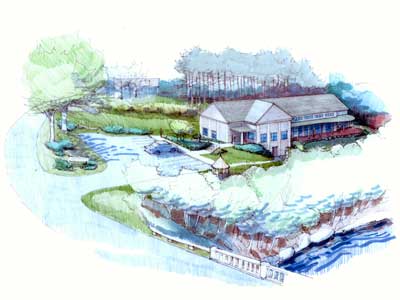Appleton is the northernmost town in Knox County. It is about 15 miles, inland from Penobscot Bay and coastal towns such as Camden and Rockland, about 30 miles east of the state capital of Augusta, and 60 miles southeast of Bangor.
Appleton is a small part of the area granted under the Muscongus Patent on March 2, 1630. The strange-sounding name merely refers to one side boundary, the Muscongus River (now called the Medomak), of the large diamond-shaped grant that was about 30 miles on each edge. The grant had various part-owners and investors down through the years, such as the Ten Proprietors and their Twenty Associates (referred to as the Thirty Proprietors), their heirs or assignees, General Samuel Waldo (son of one of the original Twenty Associates), and later General Henry Knox. After General Waldo's death, the grant was divided. The Waldo heirs obtained the larger portion, which became known as the Waldo Patent; that was the part later collected by General Knox. The Twenty associates acquired a smaller portion of about 100,000 acres in 1768, including Appleton as well as Camden, Hope, Liberty, and Montville. A few early explorers came up from the trading posts at Thomaston and Warren, and in the 1700s forest surveyors scouted the area for masts for the British Navy. Actual settlement did not occur until the beginning of the Revolutionary War, about 1775-1776. The eastern part of the general region was settled by people coming in from the coastal area of Camden and became known as Barrett's or Barrettstown after the largest owner. Later this was named Hope.
The western region became known as Appleton Plantation. The source of the name has been thought to be Nathaniel Appleton , Clerk of the Proprietor's Committee who signed early deeds, or Samuel Appleton , an early settler of Barrettstown. Recent research has found strong evidence that the town might have been named for Jose Appleton , one of the original Twenty Associates and the ancestor of many later Appletons. The eastern border of the plantation was halfway up the east side of Appleton Ridge, between the St. George River and the Ridge Road.
 Appleton incorporated as the 283rd town in Maine on January 28, 1829. Later, families in the St . George River valley petitioned the Legislature to have their section annexed to Appleton from Hope. Although Hope opposed it, the bill succeeded. On February 20, 1843, about eleven and one-half square miles on the western edge of Hope were annexed to Appleton . This included settlements at McLain's Mills, now Appleton Village, and Packard's or Smiths Mills, now North Appleton.
Appleton incorporated as the 283rd town in Maine on January 28, 1829. Later, families in the St . George River valley petitioned the Legislature to have their section annexed to Appleton from Hope. Although Hope opposed it, the bill succeeded. On February 20, 1843, about eleven and one-half square miles on the western edge of Hope were annexed to Appleton . This included settlements at McLain's Mills, now Appleton Village, and Packard's or Smiths Mills, now North Appleton.
The lumber boom in Maine brought the highest population of 1,727 in 1850. During this productive period there were sawmills, planing, shingle, stave and heading mills, cooper shops making barrels for coastal lime, fish and local apples, a gristmill, a carriage maker, tannery, mines, blacksmiths, a hotel and many other merchants. Agriculture in the form of truck gardens, strawberry farms, dairies, cattle and pig farms and orchards, was carried on in all parts of town.
New businesses took the place of some lost. Poultry and egg farms, blueberry cultivation, squash and other crops for canneries, woodcutting for lumber, pulpwood and firewood employed many. Sand and gravel pits provided material for the construction industry and highways. Recreation facilities were developed. Over 100 deer per year were killed in Appleton . Stocking of fish and game birds has improved fishing and bird hunting. Vacation cottages have been constructed at Sennebec Pond, and the West Sennebec Campground has operated since 1970. A snowmobile trail has been developed throughout the town for winter sportsmen. In recent years, poultry and cattle raising have decreased for a variety of reasons. Agriculture in general has become less important and more residents go out of town to earn a living.
Appleton Ridge rises along the center of town, about 300 feet above the average level of the village section, with the highest elevation behind the Pitman Farm 652 feet above sea level. The St .George River extends through the eastern part of town, flowing into Sennebec Pond. Pettengill Stream drains the area west of Appleton Ridge and east of Guinea Ridge, which has its highest elevation of 460 feet just north of Proctors Comer. The Medomak River has its headwaters in the western part of town. There are numerous other ponds and streams throughout the town. The many rock walls indicate the original condition of the soil. The once-cut forests are returning in large stands of pine, spruce, hemlock, birch, oak and maple.
Government is in the form of town meeting, with three selectmen, other town officials, and various assisting committees, such as the school board, budget committee, and planning and appeals boards. An annual town meeting is held in June of each year. Other town meetings are held as needed throughout the year. The Appleton Village School includes grades K to 8, and high school students attend the new Camden Hills Regional High School, as they have since 1964, when Appleton's High School closed. Other town functions are performed by the Appleton Volunteer Fire Department (1951), the Mildred Stevens Williams Memorial Library (1945), and private contractors for trash removal, snow plowing and sanding.
Appleton's Library is currently planning a new facility at the site of the old McLain's Mill along the St. George River (click to enlarge):

 Appleton incorporated as the 283rd town in Maine on January 28, 1829. Later, families in the St . George River valley petitioned the Legislature to have their section annexed to Appleton from Hope. Although Hope opposed it, the bill succeeded. On February 20, 1843, about eleven and one-half square miles on the western edge of Hope were annexed to Appleton . This included settlements at McLain's Mills, now Appleton Village, and Packard's or Smiths Mills, now North Appleton.
Appleton incorporated as the 283rd town in Maine on January 28, 1829. Later, families in the St . George River valley petitioned the Legislature to have their section annexed to Appleton from Hope. Although Hope opposed it, the bill succeeded. On February 20, 1843, about eleven and one-half square miles on the western edge of Hope were annexed to Appleton . This included settlements at McLain's Mills, now Appleton Village, and Packard's or Smiths Mills, now North Appleton.

